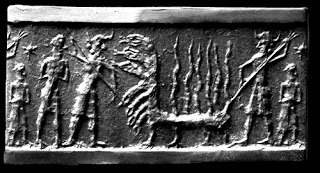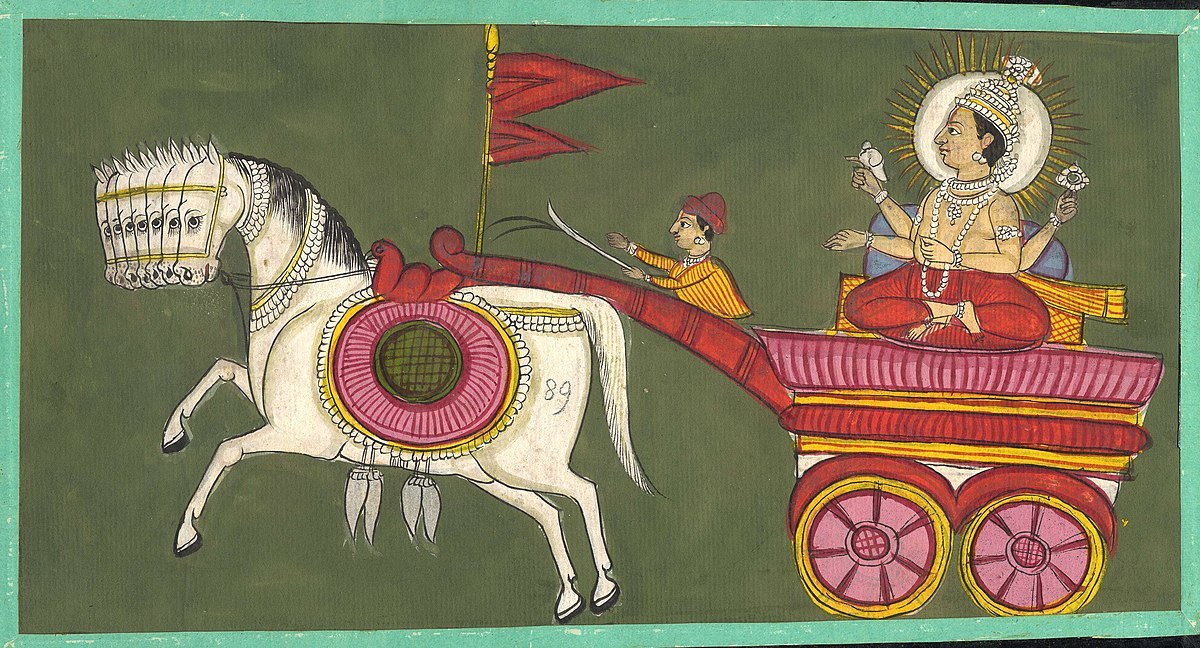In Puranic texts there is a very strange story that goes like this:
Once Lord Vishnu’s head was cut off accidentally by other gods. The head turned out to be the Sun. The gods then attached a horse head to Vishnu's body, which is how he assumed his Hayagriva form...
Of course this was not an accident, but a Vishnu's plan all along. He was planning to kill the horse-headed demon Hayagrivasura, who had stolen the Vedas, and who had received a boon that he could only be killed by someone who was horse-headed...
Of course 🙂 the fact that Vishnu's head, which turned out to be the sun, was replaced with a head of a white horse, has nothing do do with the fact that Surya, the old Vedic sun god, was directly linked to white horse...
Surya was depicted riding a chariot harnessed by seven usually white horses.

Or by a horse with seven heads.
Apparently, "it is believed that they represent the seven colors of visible light, and seven days in a week". Cool...
But is it possible that seven horse represent seven months of summer, the season dominated by the sun? You know like in Mesopotamia, where summer had seven sunny months, and fire breathing dragons, symbol of summer, had seven heads...Just asking...I talked about this in my post "Seven headed dragon"...

Also, is it possible that this is why Agni, the personification of fire, has "seven tongues"? Love the ram's grin... 🙂

In Hindu mythology, Agni was believed to have three manifestations: Sun, Lightning, Fire...Which is why he had three heads...
Just like Slavic god Triglav (Three headed)...

"Because it is a great mystery how Svarog (heavenly and earthly fire) is at the same time Perun (thunder) and Svetovid (Sun)"...I talked about this in my post "Triglav, Trimurti, Agni"...

Interesting right? Cause before people learned how to make fire, fire descended from the sun through lightning...And in India, the thunderstorm season is the summer season (Apr/May - Oct/Nov)...The season of the sun... Charts are from "Climatology of thunderstorm activity in the Indian region..."

By the way, modern science seem to confirm that it is indeed Sun (Surya) which gives power to Indra (lightning) which becomes Agni (fire)...I talked about this in my post "Sun thunder fire"...
And it is because of the fact that fire in our hearths is the same fire burning inside of the sun, that the ceremony of rekindling of the fire in the hearth, still performed in the Balkans for Orthodox Christmas, is meant to rekindle the fire of the Sun. I talked about this in my post "Badnjak"...

BTW, anyone else thinks it's funny that the saint celebrated by the Balkan Slavs, on the day when the rekindling of the sun's fire starts, is called Ignatius (Serbian "Oganj", Latin "Ignis", Sanskrit "Agni" all meaning Fire...)??? I talked about this in my post "The end of time"...
Anyay, back to Surya and horses...In some Buddhist artwork, Surya's chariot is shown as being pulled by four horses...

But that is after Greeks arrived to India...Bringing with them their sun god Helios...Who rode in a chariot pulled by four white horses. Like on this Apulian vase dated to 350BC...

Interestingly the same sun god riding on a chariot pulled by four [presumably white] horses also lived in the prime Hebrew real estate, The First Temple...I wrote about this in my post "Sun god from the First Temple"...
Oh and by the way, Slavic Sun god Svetovid, also rode on a white horse, and white horses were kept in his temples...I wrote about that in my post "Svetovid"...

Ok, let's get back to the curious "Horse Avatar" of Vishnu...Apparently "In several sources Hayagriva is a white horse who pulls the sun into the sky every morning"...Curios...Pulling sun like this?
Which is why we see things like these: Bronze Age "Sun Chariot" pulled by a horse, Denmark 1400 BC...

So what's the association between horses and sun?
Well, did you know that horse mating season is governed by the sun and it peaks on summer solstice?

I talked about this in my posts "Pegasus and chimera", "Trojan horse", "Unicorn", "Re'em", "Gray mare", "The horseman"...
Now remember this post about Surya and his wives?

When his wife Saranyu ran away, "because she couldn't stand Surya's heat any more" she ran away in a form of a white mare...Interesting...
Surya then finds Saranyu, still in the form of a mare, and after finding her, he assumes the form of a white stallion and "makes love to her"...

After which Saranyu delivers twins called Ashvins through her nose...Ouch...
Ashvins, sometimes depicted with horse heads? Those Ashvins?

Ashvins, "divine twin horsemen, traveling in a chariot drawn by horses that are never weary"? Those Ashvins?
The ones whose name Aśvínā derives from the Indo-European word for the horse, *h1éḱwo-s???
Ashvins, which just like divine horse twins from Baltic mythology, are [grand]sons of the sky god, and are pulling the sun's chariot across the sky?
Ashvins, son's of the sky god. Just like "Dioskuri", you know, Castor and Pollux, the horse twins. The guys who wanted to marry "the daughters of the white horse"...Just like Ashvins who married the daughter of Surya, who was the white horse?

You know Gemini twins...Which mark summer solstice...

Just like the Slavic deities Lel and Polel, which were originally names of the brightest stars of the Gemini constellation...The sons of the goddess Lada, just like Castor and Pollux were sons of the goddess Leda...
And so many other Horse twins from Indo-European mythology...And no one knows why horse, why twins and why Summer Solstice...
Remember, the natural breeding season of horses, marked by mad stallion fights for mares, is linked to the sun, typically begins around mid-April and finishes around mid September...And peaks on Summer Solstice...
Could this be why? Could horse twins be two fighting stallions, an animal calendar marker marking the peak of the horse mating season, which is also the peak daylight season, Summer solstice? I don't know, but it definitely fits...


Back to Surya...Here is a very interesting thing. In Vedas, Saranyu leaves Surya "because he is too hot" after the birth of Ashvin twins...
In later texts, after Saranyu's complaining about Surya's heat became unbearable, Tvastar, Saranyu's father and maker of the universe, "reduced Surya's glory", making him pleasant...
Interestingly, some other texts say that Surya asks his father in law to reduce his heat after the birth of Ashvins...Of course, cause he's the dude, and no one reduces his heat without his approval...🙂
It is after this that Saranyu's father tells Surya where to find his daughter...Surya then finds Saranyu as a mare, turns into a stallion, they mate, Ashvins get born...
Wait. What? Doesn't Saranyu leave Surya after Ashvins are born, turns to mare, gets found by cooled down Surya, who turns to stallions, they mate as horses, Ashvins are born, she leaves, he cools down, finds her, they mate as horses, Ashvins get born...
Ahhhhh...It's cyclical...It's all about climate. Cyclical, annual changes of weather in India...Remeber, Saranyu is a wet monsoon wind...Oh look...It blows from Apr to Sep...From the beginning to the end of the horse mating season...

So Saranyu, the wet, monsoon wind, could also be symbolically depicted as a white mare...She gets married by Surya, the sun, who rules the summer, period from Apr/May to Oct/Nov, the hot part of the year...Surya who also during the summer takes shape of a white sun stallion...
They elope at the peak of the horse mating season, on summer solstice, and Ashvin horse twins are born. The Monsoon proper starts after their birth...Did you know that in some stories, Ashvins were also bringers of "sweet water from the sky"?

Anyway, at the end of the monsoon season, Saranyu leaves Surya...Dry wind starts blowing and Saranyu's "lookalike" Savarna replaces her...Savarna is like Saranyu, but not her...And she is not a mare...Cause the horse mating season is over...
The day is getting shorter, until the shortest day of the winter solstice...Sun is cooling down until it reaches the lowest temperature at the beginning of spring, beginning of Feb...
Then the young spring sun, goes on looking for his bride...Saranyu, the wet monsoon. It is the heat of the sun which heats up the sea evaporating sea water, and heats up the Himalays, causing the updrift, which pulls the moist air from over the sea towards the mountains...

Saranyu comes of age...Surya gets all dappered up, goes to her party and dazzles her 🙂 The wet monsoon wind starts, right at the beginning of the horse mating season...And the cycle repeats itself...Interesting, right?
But what about Hayagriva? I almost forgot about him...What is the meaning of his mad story? Well...You know how the deity referred to as Vishnun the Vedic texts, is Surya, the supreme god from the Vedic times...
And you know how later Vishnu, basically replaced Surya on the heavenly throne...And you know how new gods usually turn old gods into demons?
I wonder if Hayagrivasura is actually Surya, taking what is his...Vedas...In whom he is the Man...Well The Sun and The Sun Horse...
And I wonder if the fact that Vishnu has to become a horse headed Hayagriva (new solar horse???) to defeat Hayagrivasura (the old solar horse???) is just a confession that he is in fact trying to be Surya? Don't know...
I mean Hayagriva is depicted "seated on a white lotus" or "holding lotus flowers". Just like Surya...Here is the Hayagriva "returning" Vedas to to Brahma...After defeating his alter ego...

Lotus flowers...The flowers that flower during monsoon season? Interesting, cause Hayagriva's consort is Lakshmi...You know, Goddess of the lotus...This super cool girl...
I talked about her in my post about "Lajjā (Modesty)", Hindu goddess associated with abundance, fertility and sexuality, and invoked for abundant crops (vegetative fertility) and good progeny (human fertility)...

Well actually, Hayagriva's consort is Marichi, who is "an incarnation of Goddess Lakshmi" and "the goddess of...the sun's light which is the life force of all things" and "who is seen as the female aspect of Hayagriva"...🙂
BTW, why lotus? Lotus is the herald of the peak of the rainy season....It's peak flowering season is July-August, the peak monsoon season in the Ganga river catchment area...
Anyway...Maybe now this strange link between the horses and the sun is not as strange any more...Maybe...
BTW, I am actually amazed how much of this ancient stuff was preserved in Indian culture...Hidden in plain sight though...

























































